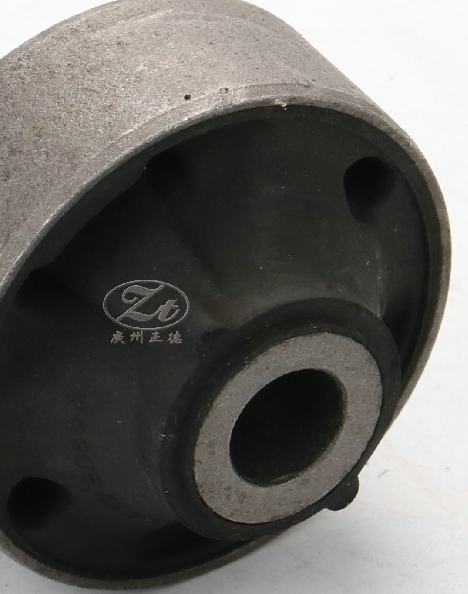Email format error
Email cannot be empty
Email already exists
6-20 characters(letters plus numbers only)
The password is inconsistent
Email format error
Email cannot be empty
Email does not exist
6-20 characters(letters plus numbers only)
The password is inconsistent

News

A Complete Guide to Replacing the Nissan Versa Lower Control Arm Bushing
The Nissan Versa lower control arm bushing is a small but critical part of the car’s suspension system. It connects the control arm to the vehicle’s frame and helps absorb vibrations and shocks, ensuring a smooth, comfortable ride. Over time, however, these bushings can wear down, leading to a variety of issues from poor handling to uneven tire wear. In this guide, we’ll cover everything you need to know about lower control arm bushings, specifically for Nissan Versa models, including signs of wear, replacement options, and detailed installation tips.
Whether you're a seasoned DIY mechanic or a Nissan Versa owner looking to understand more about vehicle maintenance, this guide has you covered.
What Is a Lower Control Arm Bushing?
The lower control arm bushing is a small, cylindrical component, typically made of rubber or polyurethane, that sits between the control arm and the frame of the vehicle. The control arm, in turn, connects the wheel assembly to the vehicle's body. When in good condition, this bushing helps dampen vibrations, absorbs road shocks, and stabilizes the wheels.
Key Functions of Lower Control Arm Bushings:
- Shock Absorption: The bushing absorbs the shocks and impacts from the road, creating a smoother driving experience.
- Vibration Damping: It reduces vibrations transmitted to the steering wheel and chassis, contributing to a more comfortable ride.
- Vehicle Stability: Keeps the control arm securely in place, allowing for precise and safe steering.
Importance of the Nissan Versa Lower Control Arm Bushing
In Nissan Versa models, the control arm bushings play an especially important role because the Versa is known for its smooth ride and reliability. Control arm bushings in this vehicle model contribute significantly to the handling characteristics, affecting how the car performs under different driving conditions. The bushings ensure that:
- Steering is Accurate and Responsive: Good bushings ensure that the control arms and wheels move in sync, providing precise control.
- Vibration and Noise Are Minimized: Proper bushings prevent metal-on-metal contact, reducing noise and harshness in the cabin.
- Tire Wear is Even: With solid bushings, the control arms hold the tires at the correct angles, reducing uneven tire wear.
Signs You Need to Replace Your Nissan Versa Lower Control Arm Bushing
Lower control arm bushings gradually wear down, particularly if you drive on rough roads or take sharp turns often. Recognizing the signs of a failing bushing can help you avoid further damage to the suspension system.
Common Signs of Worn Lower Control Arm Bushings:
1. Vibration in the Steering Wheel: If you feel unusual vibrations while driving, especially at high speeds, this can be a sign of worn control arm bushings.
2. Clunking Noises: Strange clunking sounds, especially when driving over speed bumps or making turns, can indicate bushing wear.
3. Poor Alignment and Steering Drift: A worn bushing can lead to misalignment, causing the car to drift or pull to one side.
4. Uneven Tire Wear: If the tires are wearing unevenly, it may be due to poor control arm positioning caused by deteriorated bushings.
Tip: In older models, such as the 2012-2015 Nissan Versa, it’s also recommended to inspect the engine mount for Nissan Sunny N16 and Sentra, as this component can impact suspension performance if worn.
Choosing the Right Control Arm Bushing for Your Nissan Versa
When replacing Nissan Versa lower control arm bushings, selecting the right type is essential. There are several types of bushings to consider, each with its pros and cons.
Types of Control Arm Bushings:
|
Bushing Type |
Material |
Pros |
Cons |
|
Rubber |
Rubber |
Excellent vibration damping, cost-effective |
Shorter lifespan |
|
Polyurethane |
Polyurethane |
Durable, resistant to wear, great for handling |
May transfer more vibrations |
|
OEM |
Rubber or Poly |
Perfect fit, manufacturer standard |
Usually higher in cost |
|
Aftermarket |
Various |
Wide range of materials and options |
Compatibility may vary |
Key Factors to Consider:
1. Material: Rubber is great for comfort but wears faster, while polyurethane is more durable and suited for performance.
2. Fitment: Ensure that the bushing is compatible with your specific Nissan Versa model and year.
3. Brand Quality: Choosing well-known brands or OEM parts generally ensures a longer-lasting component.
Step-by-Step Installation of the Lower Control Arm Bushing
Replacing the Nissan Versa lower control arm bushing is a task that requires basic mechanical knowledge, the right tools, and patience. Here’s a step-by-step guide to help you through the process.
Required Tools and Supplies
- Jack and jack stands
- Wrench set
- Pry bar
- Hammer and mallet
- Replacement control arm bushings (OEM or aftermarket)
- Grease (if using polyurethane bushings)
Installation Process
1. Lift and Secure the Vehicle
- Park the car on a flat surface and lift it with a jack. Place jack stands under the vehicle to ensure stability.
2. Remove the Wheels and Locate the Control Arm
- Remove the front wheels to access the control arm. Identify the control arm and locate the bushings.
3. Detach the Control Arm from the Frame
- Using a wrench, loosen and remove the bolts that secure the control arm to the vehicle frame. Be prepared for some resistance.
4. Inspect the Old Bushings
- Examine the old bushings for signs of wear, cracks, or tears. Worn bushings may appear disintegrated or flattened.
5. Remove the Old Bushing
- Use a pry bar or press tool to remove the old bushing. A hammer can help dislodge stubborn bushings.
6. Install the New Bushing
- Grease the new bushing if it’s made from polyurethane (to prevent squeaking) and press it into place. Ensure that the bushing is aligned correctly.
7. Reassemble the Control Arm
- Secure the control arm back in place, torque the bolts to the manufacturer’s specifications, and reattach the wheel.
8. Lower the Vehicle and Test Drive
- Carefully lower the car and take it for a test drive. Listen for any unusual noises and observe handling and steering stability.
Cost of Replacing a Nissan Versa Lower Control Arm Bushing
The cost of replacing lower control arm bushings varies based on the type of bushing, whether it’s an OEM or aftermarket part, and labor costs if you choose professional installation.
Estimated Costs:
- Parts: $20 - $80 per bushing (rubber) and $50 - $150 (polyurethane)
- Labor: $100 - $250 if done professionally
- DIY Replacement: Much cheaper but requires the proper tools
Pro Tip: If you’re not experienced in car repairs, it might be worth paying for professional installation to ensure safety and proper alignment.
FAQs
1. How often should you replace Nissan Versa lower control arm bushings?
Most bushings last between 50,000 and 100,000 miles, but they should be inspected during routine maintenance, especially if you drive on rough roads.
2. Can I replace just one bushing, or do I need to do both sides?
It’s usually recommended to replace both sides to maintain balance and consistency in handling.
3. Are polyurethane bushings better than rubber for my Nissan Versa?
Polyurethane bushings offer better durability and performance but may increase vibration. Rubber is more comfortable but wears faster.
4. Do I need an alignment after replacing control arm bushings?
Yes, it’s generally recommended to get an alignment to ensure proper handling and avoid uneven tire wear.

Conclusion
The Nissan Versa lower control arm bushing is a key component in the vehicle’s suspension system. By understanding the role it plays, recognizing signs of wear, and choosing the right replacement options, Nissan Versa owners can enjoy smooth handling, improved stability, and a quieter ride. Proper installation or opting for a professional service ensures that your vehicle remains in top shape for years to come.
Keeping up with these maintenance tasks not only extends the life of your vehicle but also enhances safety and driving enjoyment. So, whether you’re a DIY enthusiast or a car owner new to maintenance, this guide has provided a comprehensive overview of everything you need to know about replacing and maintaining your Nissan Versa lower control arm bushing.

